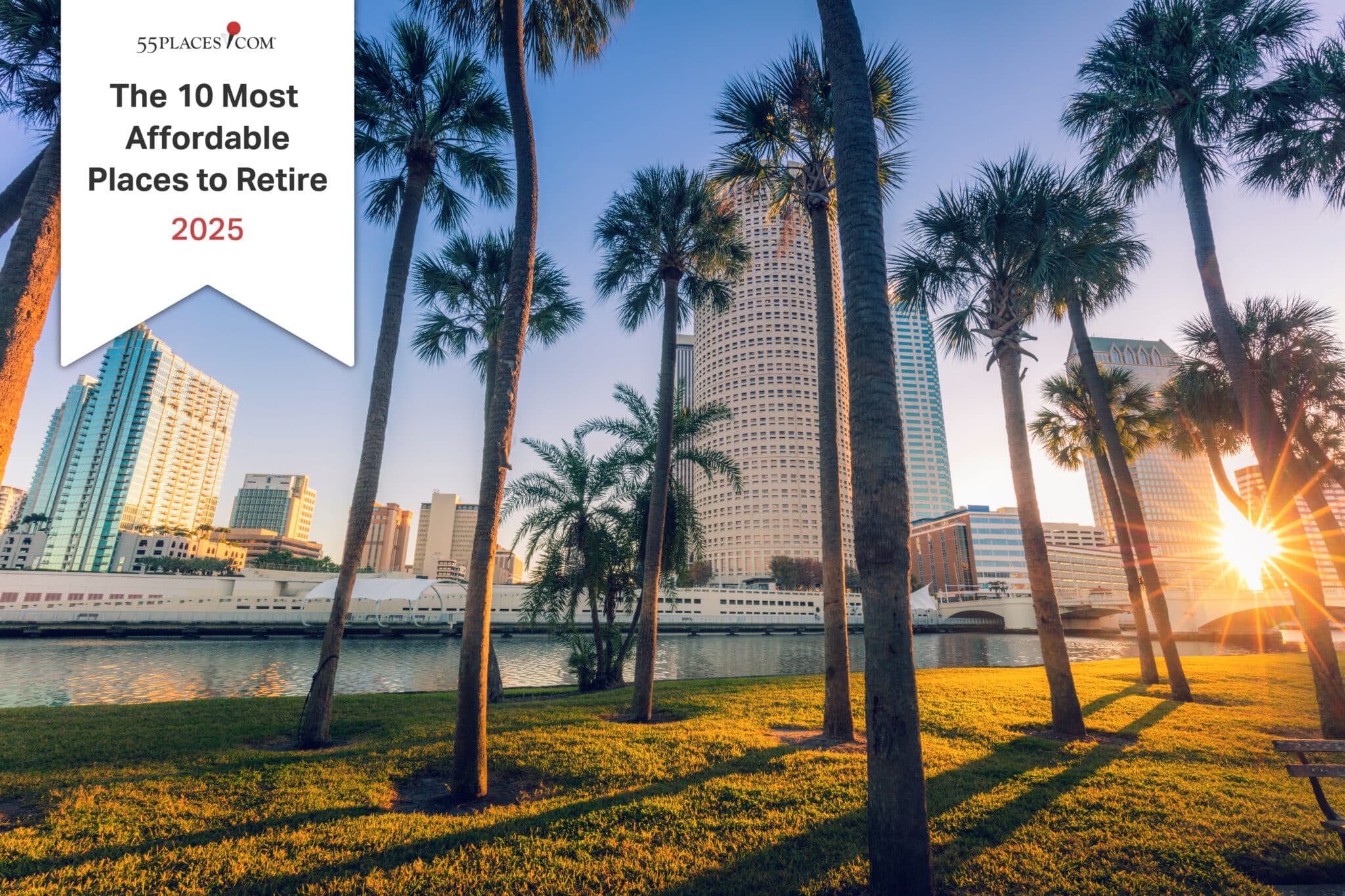Retirement opens the door to a whole world of possibilities. You get to decide where you want to spend your golden years. What’s your ideal climate? What kind of home do you want to live in? What activities do you want nearby? As active adults seek to answer those questions, many of them want to keep affordability in mind. But where are the most affordable places to retire?
Let’s explore the top 10 most affordable 55+ housing markets and take a look at the median home price, the cost of living, and what makes them attractive for retirees. Each one offers affordable home prices while still providing active adults looking to relocate with access to numerous amenities and community options.
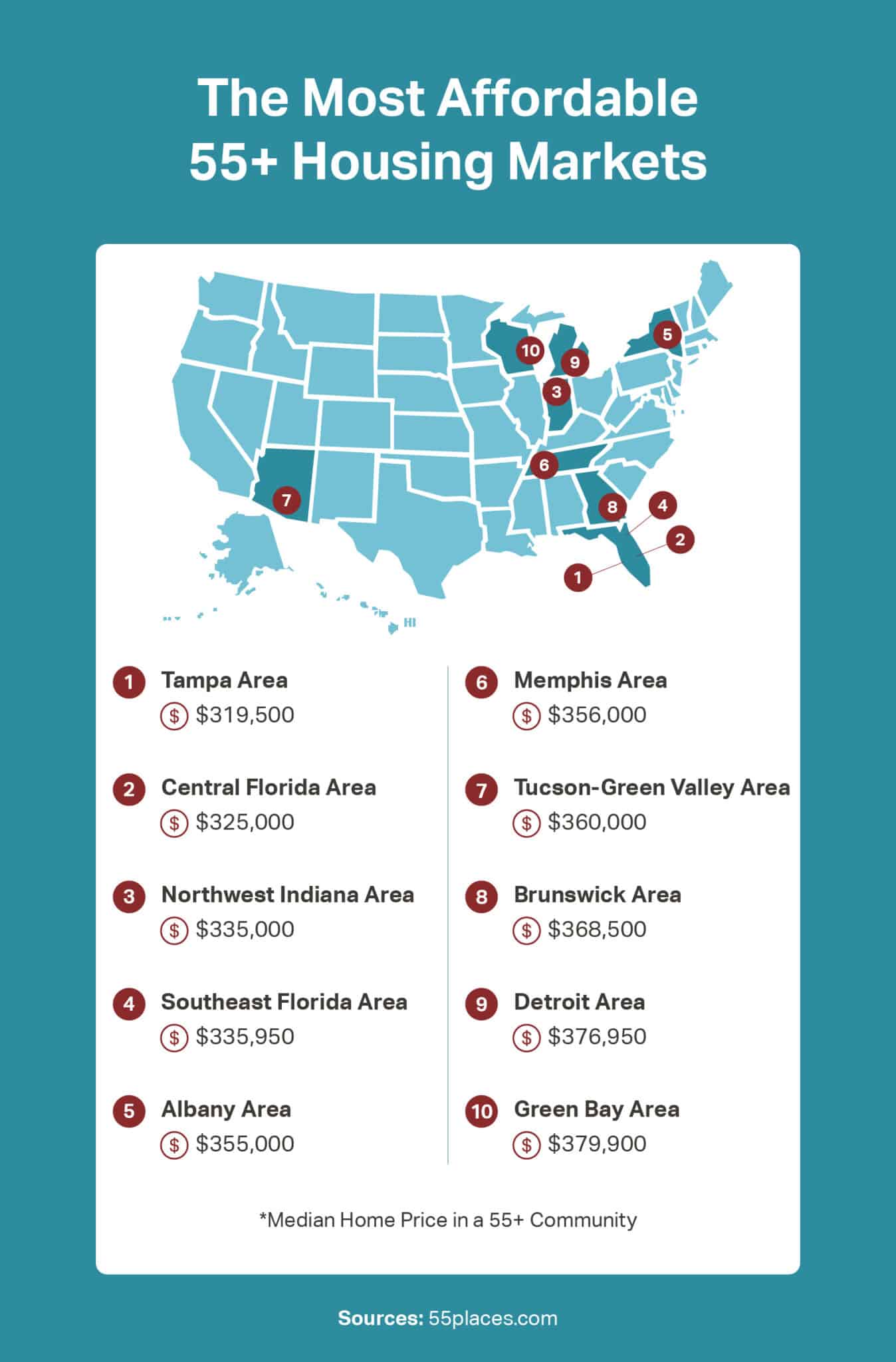
1. Tampa Area
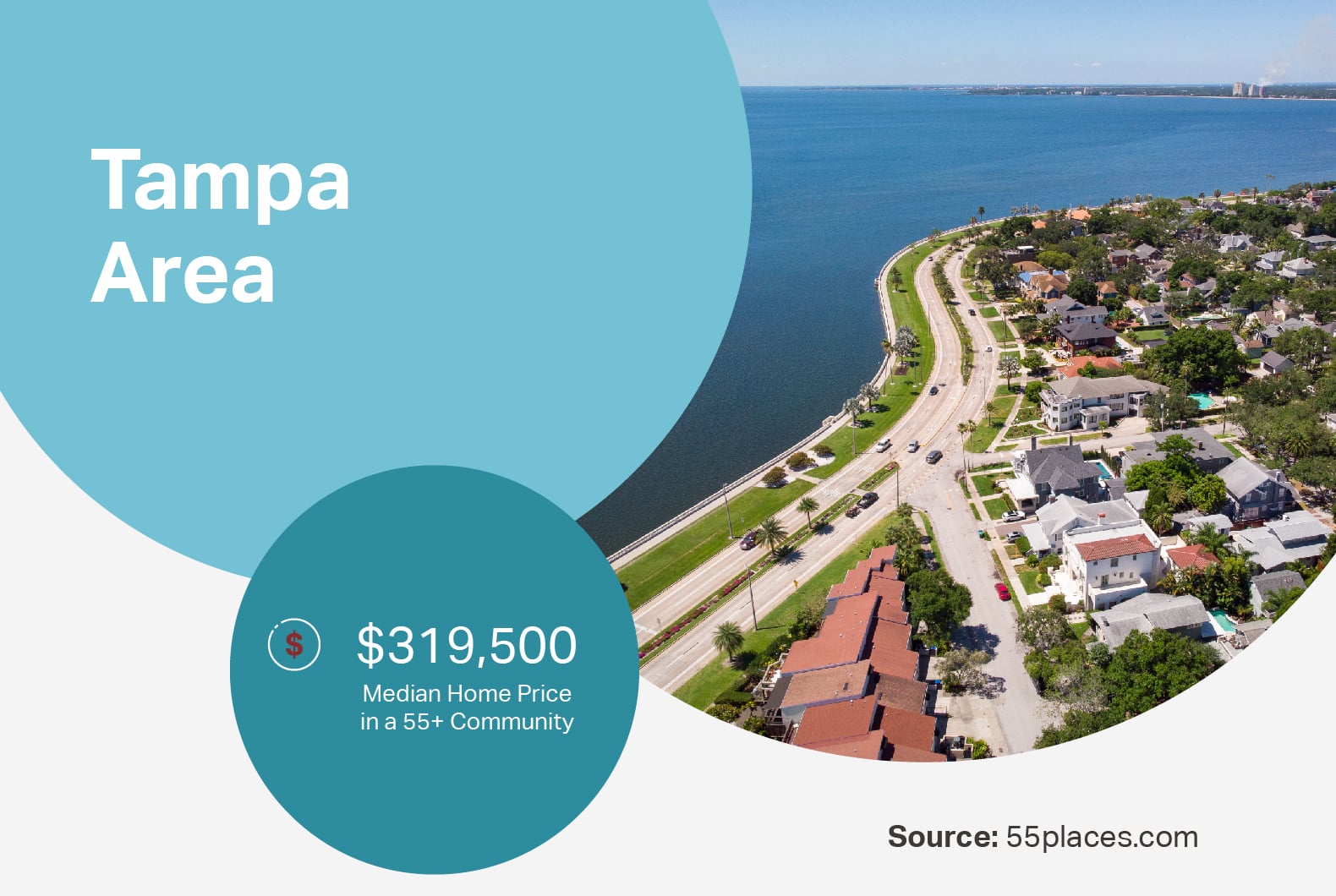
Florida is a retirement hotspot, but there are many pockets of affordability throughout the Sunshine State. The Tampa Bay area is a metropolitan area located on the state’s Gulf Coast, comprising cities such as Tampa, St. Petersburg, and Clearwater. Get to know what the cost of living and the retirement lifestyle look like in this part of Florida.
Cost of Living
The median list price of a home in a 55+ community in the Tampa Bay area is $319,500, according to internal sales data from 55places.com. Within the larger market, housing expenses in this metro area is 6% lower than the national average, according to Payscale.
In addition to housing, health care is an essential consideration for many retirees. Health care costs in the Tampa Bay area are also 7% lower than the national average, according to Payscale.
While you can find overall cost of living savings in the Tampa Bay area, you may find that some expenses, like groceries and utilities, are higher than the national average.
Why It’s Great for Retirement
Retirees flock to Florida for its year-round sunshine, and you will find plenty of that in the Tampa Bay area. It has a subtropical climate characterized by a hot and wet season during one half of the year and a cooler, drier season during the other half. For many active adults looking to leave behind heavy snows and winter’s chill, this weather offers a welcome change.
While health care can be less expensive in the Tampa Bay area, residents still have access to several health systems and hospitals: Tampa General, AdventHealth, USF Health Care, and BayCare. The Department of Veterans Affairs (VA) also has a strong presence in this part of Florida.
The Tampa Bay area offers its residents all the joys of coastal living with the benefit of more affordability. If you want to feel the sand between your toes, you have your pick of beautiful beaches. If you want to spend your retirement out on green, the Tampa Bay area is perfect for year-round golfing on scenic and challenging courses.
While outdoor enthusiasts will be spoiled for choice in the Tampa Bay area, you will also find a wealth of cultural activities, including museums and theaters. Additionally, the area’s major cities are playgrounds for dining out and shopping.
2. Central Florida Area

Central Florida includes several major cities, including Orlando, Lakeland, and Kissimmee. While this part of the state is not located on the shores of the Gulf or the Atlantic, it’s dotted with lakes and springs that offer plentiful waterfront views and activities. Like the Gulf Coast of Florida, this part of the Sunshine State attracts retirees with its affordability.
Cost of Living
The median list price of a home in a 55+ community in Central Florida $325,000, according to internal sales data from 55places.com. This is a large swath of the state, so the cost of living varies, but affordability is a consistent theme. For example, the cost of living in Orlando, the biggest city in the area, is 4% lower than the national average, according to Payscale. In Kissimmee, the cost of living is 11% lower than the national average, according to Payscale.
Housing is one of the biggest areas for savings in Central Florida, with the cost of homes significantly lower than the national average. Health care is also less expensive in Central Florida, but groceries and utilities are slightly more expensive.
Why It’s Great for Retirement
Like the rest of the Sunshine State, Central Florida has hot summers and cool, dry winters. But some retirees may be attracted to the area’s distance from the state’s coasts. While Central Florida is not immune to hurricanes, their intensity will be weaker inland.
The metro areas in Central Florida offer ample access to quality health care at hospitals like AdventHealth Orlando and Orlando Health-Orlando Regional Medical Center. With nearby hospitals, active adults can access the primary and specialty care they need in retirement.
Central Florida is known for its theme parks. You and visiting grandkids will love the proximity to Disney World and Universal Studios. But there’s still plenty to do once you step off the rides. Wildlife is abundant in this part of Florida. Birdwatchers, anglers, and hikers will find plenty of spots to explore. You’ll also find quaint antiques districts and delicious eateries, both well-known and hidden gems, throughout Central Florida’s metro areas.
3. Northwest Indiana Area

Northwest Indiana may not be in Illinois, but it is considered a part of the Chicago metro area. It includes cities like Chesterton, Crown Point, La Porte, Michigan City, and Valparaiso. While it enjoys close proximity to the Windy City, it offers a much more reasonable cost of living. You can easily visit Chicago to take advantage of its restaurants, theaters, museums, and shopping. You can also enjoy unique attractions closer to home, all while taking in the views on the shores of Lake Michigan.
Cost of Living
The median list price of a home in a 55+ community in Northwest Indiana, also commonly referred to as “Da Region,” is $335,000, according to internal sales data from 55places.com. Lake County, one of several included in this region of Indiana, has a cost of living 12.7% lower than the national average, according to Best Places. The cost of living in Indiana as a whole is 16.3% lower than the national average, according to Best Places.
Why It’s Great for Retirement
Northwestern Indiana is a part of the Midwest, which means you can expect four distinct seasons. If you like hot summers and cold winters, you’ll feel right at home. For active adults who want to remain close to family in the Midwest but reduce their living expenses, this part of the Chicago metro area may be the perfect solution.
Settling down in the Da Region will give active adults easy access to many options for high-quality health care both in Indiana and nearby Chicago. Some Chicago health systems even have locations in the region. For example, UChicago Medicine has a facility in Crown Point. This part of the state is also home to health systems like Powers Health and Northwest Health.
You can rest easy knowing that you can get the health care you need, and you can get excited about all of the things you can enjoy here during your retirement years. With a prime location on Lake Michigan, you can embrace waterfront living with beaches, boating, and fishing. The region is also home to its own national park: the Indiana Dunes.
The area also has a robust craft beer and wine scene. Hop on the South Shore Brewery Trail to discover more than 20 local spots, or sip on different vintages on the winery trail. However you envision your retirement, you can find activities, both indoor and outdoor, in Indiana to build the lifestyle you want.
4. Southeast Florida
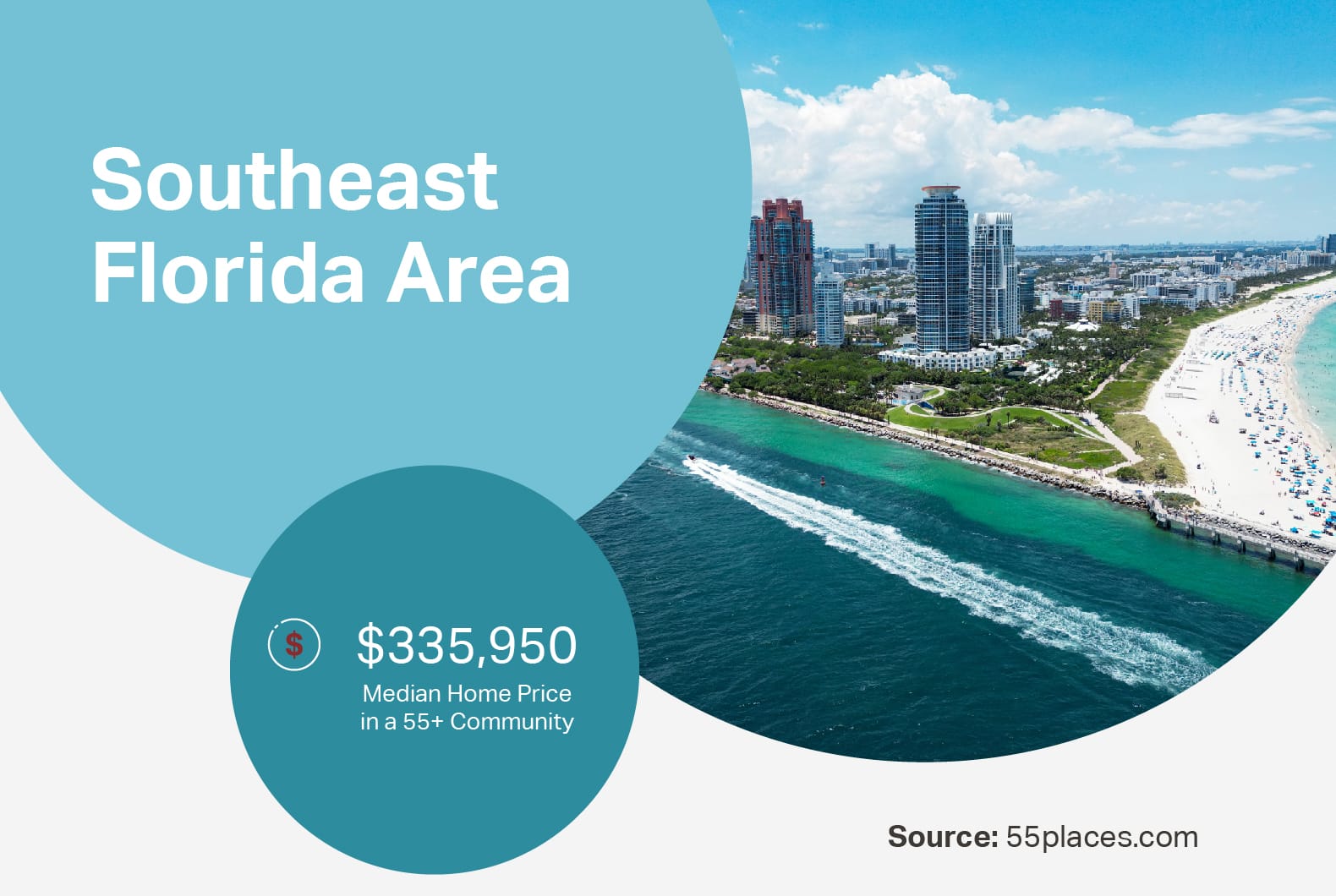
When you picture Florida, the Southeastern region of the state might be what first comes to mind. It’s the most populous part of the state and includes three counties: Broward, Miami-Dade, and Palm Beach. Parts of the area, like Miami, are not known for their affordability, but active adults can find spots that offer a more reasonable cost of living.
Cost of Living
The median list price of a home in a 55+ community in Southeast Florida is $335,950, according to internal sales data from 55places.com. If you’re keen on saving on the cost of a home, you can find opportunities in this part of Florida. The 55+ communities in Florida, for example, offer a lot of flexibility when it comes to your budget.
Keep in mind, the overall cost of living in this part of the state tends to be higher than the national average.
Why It’s Great for Retirement
The Sunshine State speaks for itself when it comes to the weather. You can soak up the sun on the beach during the hottest months of the year, and the temperature will remain warm enough that you rarely have to think about putting your golf clubs away.
If health care is top-of-mind for you while you weigh your options for your retirement location, you’ll find plenty of options in this populous part of the state. The University of Miami Health System and Mount Sinai Medical Center are prominent in Miami. In Palm Beach, consider options such as Palm Beach Health Network and Juniper Medical Center.
Southeastern Florida attracts retirees and tourists alike because it’s so rich in things to do. You can embrace the waterfront lifestyle with boating and beach days. If you love to fish, you can cast your line in the Florida Keys. You can also lose yourself in the urban delights of Miami and soak in the Art Deco architecture, try a new restaurant, or see a concert. This vibrant location caters to a wide range of hobbies and lifestyles.
5. Albany Area
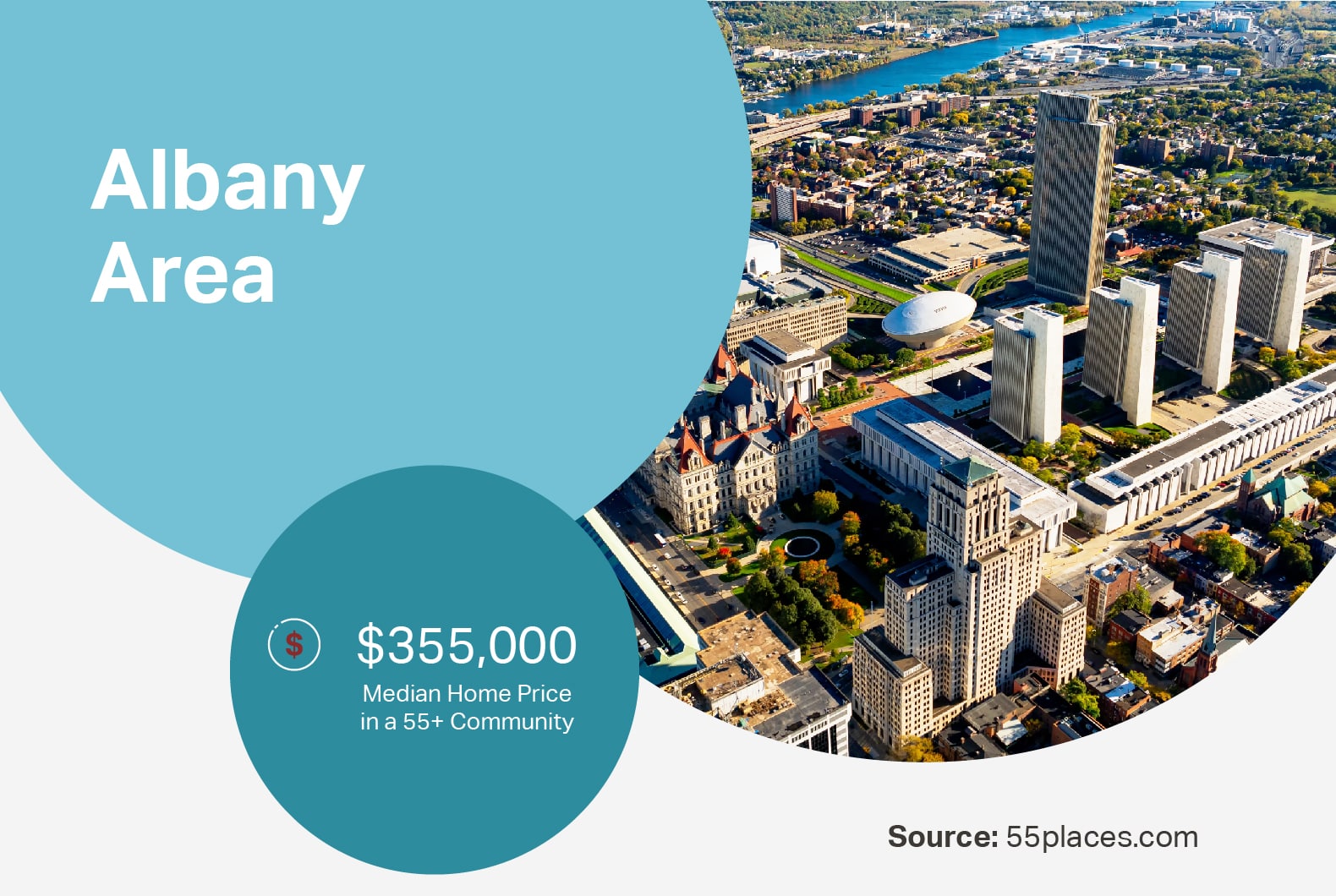
New York is often associated with a high cost of living, but life outside of New York City might surprise you with its affordability. Albany, the state capital, is about three hours north of NYC, and it can be an ideal retirement spot for active adults looking to reduce their cost of living while still enjoying access to plenty of activities to enrich their lives.
Cost of Living
The median list price of a home in a 55+ community in Albany is $355,000, according to internal sales data from 55places.com. The overall cost of living in this city is 5% higher than the national average, according to Payscale. But for anyone who is looking to remain in the Northeast in their retirement years, Albany can be comparatively more affordable than NYC. If you want to remain close to children and grandchildren in NYC or other more expensive parts of the Northeast, this Upstate New York city has a lot to offer in terms of savings.
Why It’s Great for Retirement
Retirement doesn’t have to mean trading in seasons for non-stop sunshine. Albany has four distinct seasons, a boon for anyone who loves to feel the first crisp winds mark the end of summer and the spring thaw that promises warmer days ahead. Fall may be the city’s most beautiful time of year thanks to the red and gold hues of the changing leaves. Keep in mind you will likely see the heavy snows characteristic of the Northeast, but many 55+ communities in the area have homeowners’ association (HOA) fees that cover snow removal.
Albany may not be NYC, but it’s still a busy metro area. Naturally, it has several major health systems that ensure active adults can get the primary and specialty care they need. St. Peter’s Hospital and Albany Medical Center are two of the area’s major hospitals, and the VA also has a medical center located there.
Upstate New York has a reputation for being scenic, one that it lives up to in Albany. The city is located on the Hudson River. You can enjoy its riverfront parks and even take a cruise on the Hudson for a different way to take in the views.
Albany boasts all the hallmarks of a vibrant city, including arts and culture, dining, shopping, and nightlife. Plus, you are never far from the great outdoors. Parks within the city and nearby nature preserves offer beautiful spots for walking, hiking, biking, and kayaking.
6. Memphis Area
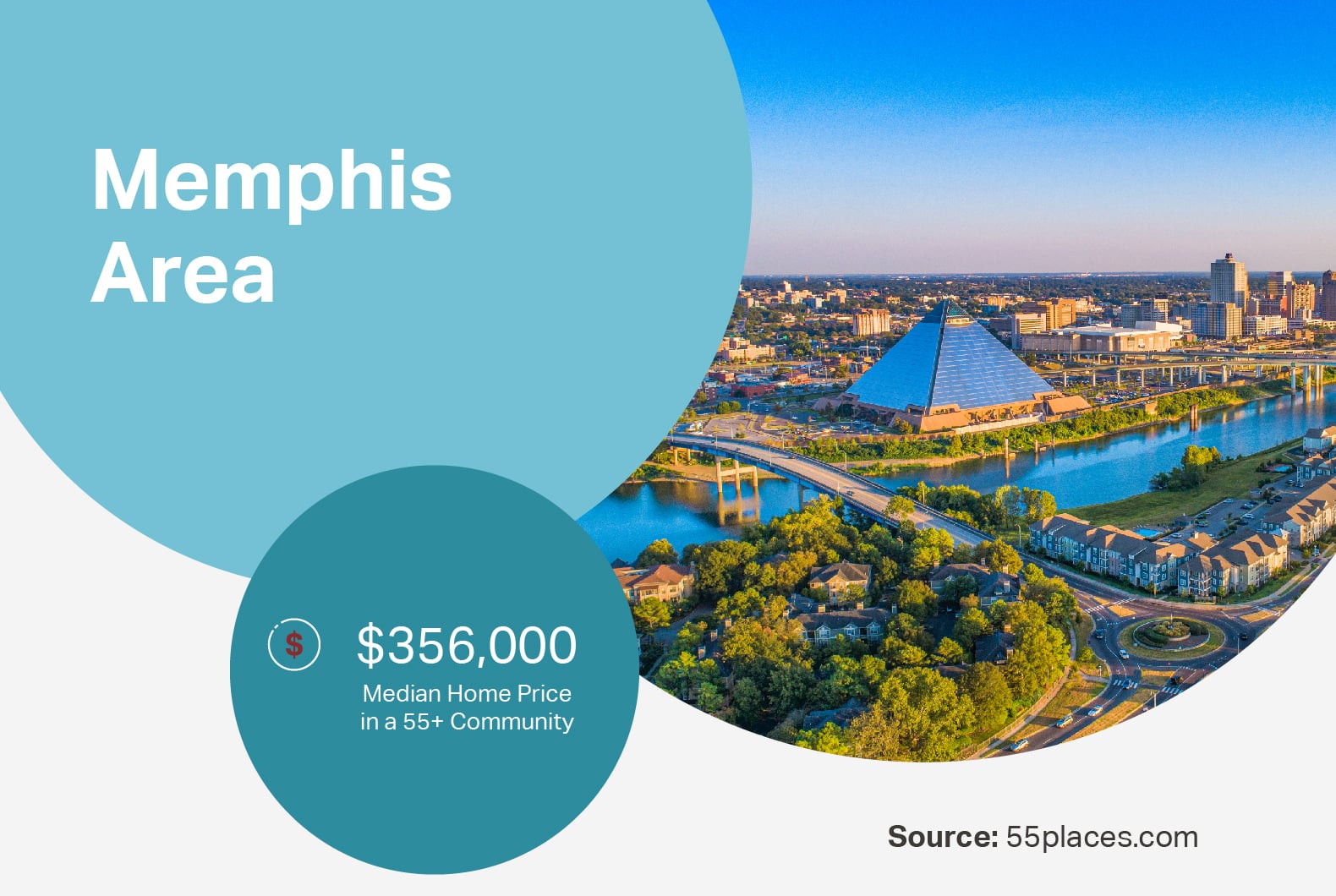
Memphis, Tennessee, is synonymous with the blues, soul, and rock ‘n’ roll. This Southern city is steeped in musical history, and it remains a city of music to this day. The warmth of the city, both literally due to its weather and figuratively thanks to its welcoming vibe, makes it a desirable retirement spot. Plus, all of that charm comes with the big benefit of affordability.
Cost of Living
The overall cost of living in Memphis is 10% lower than the national average, according to data from PayScale. If saving on housing is a top priority, you’ll be pleased to find that housing expenses in the Home of the Blues are 14% lower than the national average, according to Payscale. The median list price of a home in a 55+ community in Memphis is $356,000, according to internal sales data from 55places.com.
The cost of food, utilities, and groceries all fall below the national average, making Memphis a high contender on the list of most affordable retirement cities.
Why It’s Great for Retirement
If you’re looking to bask in warm days and a bit of humidity doesn’t bother you, then Memphis is the place for you. It has steamy summers and cold but manageable winters. While you might see a few inches of snow, Memphis rarely experiences freezing temperatures. The transitional seasons of fall and spring offer some of the most enjoyable times of the year.
Memphis and its surrounding metro area are home to many hospitals and health care providers that can help retirees get the care they need to remain healthy and active. Baptist Memorial Hospital and Methodist Hospitals of Memphis are two of the area’s top-performing hospitals.
Music tops the charts of things to do in Memphis. If you’re new to the area, you can experience Graceland and visit the Stax Museum of American Soul Music. As you get settled and start living like a local, you’ll always be able to find live music. Just walk over to Beale Street! You’ll also be treated to a full calendar of music fests of all different genres.
Even if music isn’t your beat, Memphis has plenty to offer. The city is renowned for its vibrant food scene, particularly its barbecue, as well as its thriving brewery and distillery scene. You can also enjoy the city’s urban parks and its beautiful views of the Mississippi River.
7. Tucson-Green Valley Area

This area, including the urban center of Tucson and the unincorporated community of Green Valley, basks in Arizona’s iconic heat and sunshine. That dry heat attracts many retirees who love the sun but prefer to avoid the humidity prevalent in other retirement hotspots.
Cost of Living
This part of Arizona does offer some cost savings for retirees. The median list price of a home in a 55+ community in the Tucson-Green Valley area is $360,000, according to internal sales data from 55places.com. Also, the state does not tax Social Security benefits, a boon for your retirement years.
Housing savings are definitely a plus in the Tucson-Green Valley area, but you might find that the overall cost of living is a bit higher than the national average, according to Payscale data. If you’re moving from one of the many high-cost-of-living areas in the U.S., your budget may still stretch much further here in the Grand Canyon State.
Why It’s Great for Retirement
The Southwest offers a stark beauty characterized by the deep reds, shimmering golds, and rich browns of its desert climate. When you step outside, you’ll be greeted by the brightly shining sun and the embrace of a dry heat. You won’t see too much rain in this arid area, and winter temperatures will more likely call for a light jacket than bundling up.
As you evaluate different retirement options, health care is likely a significant factor. The Tucson-Green Valley area offers easy access to high-quality hospitals, including Banner University Medical Center and TMC Healthcare.
If you want to immerse yourself in the natural beauty of Arizona, Saguaro National Park is only 30 minutes outside of the Tucson area. See the iconic cacti of the Southwest and explore the park on foot or by bike. Despite the intense heat, you can catch fascinating glimpses of both flora and fauna that thrive under the sun.
You can also get to know the local flavors of the area through a year-round farmers market that pops up in Green Valley and neighborhoods throughout Tucson. While the heat is certainly a draw, you can find respite from the ever-shining sun in the area’s shops, restaurants, and museums.
8. Brunswick Area

Cities like Atlanta and Savannah are more well-known, but Georgia has plenty of hidden gems, with Brunswick among them. This city is situated on the southeastern coast of the Peach State, bordered by rivers that flow into the warm waters of the Atlantic Ocean. It blends a distinctive Victorian flair with a modern, urban ambiance. And for the budget-conscious retiree, Brunswick offers a more affordable cost of living.
Cost of Living
The median list price of a home in a 55+ community in the Brunswick area is $368,500, according to internal sales data from 55places.com. According to Best Places, housing is 9.1% less expensive than the national average in the general market. Living in this city is also less expensive than many other areas of the Peach State.
Why It’s Great for Retirement
Brunswick has a subtropical climate, which means hot, humid summers and cold, wet winters. However, those cold winters rarely reach freezing temperatures, making this Georgia city a welcome respite for retirees accustomed to snow and ice. If you love the heat, the summer days are yours to enjoy. And when the seasons turn, you can manage the colder stretches without ever breaking out a snow shovel.
Brunswick is a relatively small city, but it still offers plenty of options for your health care needs. The Southeast Georgia Health System has a campus in the city. If you prefer to receive care in larger metropolitan areas, both Savannah and Jacksonville, Florida, are within driving distance.
Brunswick has the quaint charm of a smaller city, but it does not lack opportunities for exploration and enjoyment. You may come to love the Lover’s Oak, a tree that has witnessed hundreds of years of history, shading a corner in Downtown Brunswick. The city also has parks that offer scenic views, walking trails, and dog parks. With its prime location on the coast, you are always within easy reach of the Golden Isles. These four barrier islands offer a serene setting for spending time on the water. They also have a collection of spas, shops, and restaurants.
As you embrace life in Brunswick, you’ll probably find yourself drawn to the city’s historic downtown. You can lose yourself in its antique stores, catch a live show at The Ritz Theatre, or find your new favorite spot to eat.
9. Detroit Area

Detroit is currently undergoing a renaissance. The city filed for bankruptcy in 2013 due to job losses and a declining population, leaving it in dire straits. However, it has since been rebuilding itself. The downtown area has undergone revitalization, and its population is once again on the rise. While major, positive change has come to Detroit, it’s still on its journey of rebirth. Still seen as an up-and-coming city, certain parts of Motor City offer more affordability for retirees considering spending their golden years in the Midwest.
Cost of Living
The cost of living in Detroit is not the least expensive in the country. You might find that your expenses are on par with or slightly higher than the national average, but that you still feel a sense of financial relief if you’re coming from a high-cost-of-living area. Plus, you may find that buying a home is more reasonable. The median list price of a home in a 55+ community in Detroit is $376,950, according to internal sales data from 55places.com.
Why It’s Great for Retirement
Detroit is a Midwestern city, which means you can expect four distinct seasons. Temperatures in the summer will often be in the 80s, while winter will mean snow and freezing temperatures. For active adults who enjoy the changing seasons, Detroit will certainly deliver. If you’re concerned about shoveling, many of the 55+ communities in the area offer low-maintenance living. The community will take care of that outdoor maintenance, leaving you to enjoy the beauty of the latest snowfall.
Detroit is the largest city in Michigan, and it has several health care providers serving its population, including the University of Michigan Health and Corewell Health William Beaumont University Hospital. While less expensive than many other large cities in the country, you can still access quality health care.
Detroit is buzzing with all of the activity you would expect from a big city. If you love to root for a hometown team, you can proudly support the NFL’s Lions, the MLB’s Tigers, and the NHL’s Red Wings. The city is also home to its own style of pizza, and finding your favorite spot for a slice is an important part of calling Detroit home. The city also has a beautiful riverfront and plenty of greenspace to beckon you outdoors.
10. Green Bay Area

Wisconsin offers another haven of affordability for retirees. On the shores of Lake Michigan, Green Bay just might be the ideal city for your lifestyle and your budget. Football fans are likely familiar with the passionate Packers fans and intense team rivalries. Sports are close to the city’s heart, but there’s plenty more to love about Green Bay.
Cost of Living
The median list price of a home in a 55+ community in the Green Bay area is $379,900, according to internal sales data from 55places.com. Housing is 19% less expensive than the national average, and the overall cost of living is 9% lower than the national average, according to Payscale. You’ll also save on utilities and groceries; both are less expensive than the national average.
Why It’s Great for Retirement
Welcome to warm summers on the lake. In Northeastern Wisconsin, the hot, sunny days are balanced by the cold, snowy winter months. If you enjoy the look and feel of winter but prefer a more relaxed lifestyle, active adult communities in the Green Bay area may be worth exploring. Many of these communities handle the outdoor work.
Also, several health systems have locations in Green Bay. You can find primary and specialty care with providers Aurora BayCare Medical Center, Bellin Health, and HSHS St. Vincent Hospital.
Wisconsin is a state that embraces the outdoors, and Green Bay is no exception. You can roar with the crowd at Lambeau Field, or opt for the quieter experience of the Green Bay Botanical Garden. Plus, the Fox River runs through the city. You can enjoy that riverfront access and its bountiful options for fishing and boating. Green Bay is also a city for bikers. Hop on scenic trails along the river and through nearby state parks.
The colder months may mean more time indoors, but you’ll find restaurants, breweries, wineries, and museums to fill you with warmth, food, and entertainment. If you want to eat like a local, the hearty foods of America’s Dairyland will keep you nice and toasty in winter. Find your favorite local spot for brats and cheese curds.
Finding Your Retirement Spot
The most affordable places to retire give retirees the flexibility of lower home prices while still offering a high quality of life. Whether you’re retiring on a fixed income or looking to make the most of your savings, the right community is out there for you.
But you don’t navigate the search alone. Connect with a real estate expert at 55places.com who can guide you to 55+ communities that match your lifestyle, needs, and budget. Start your journey today and find the perfect place to enjoy your retirement with confidence!

